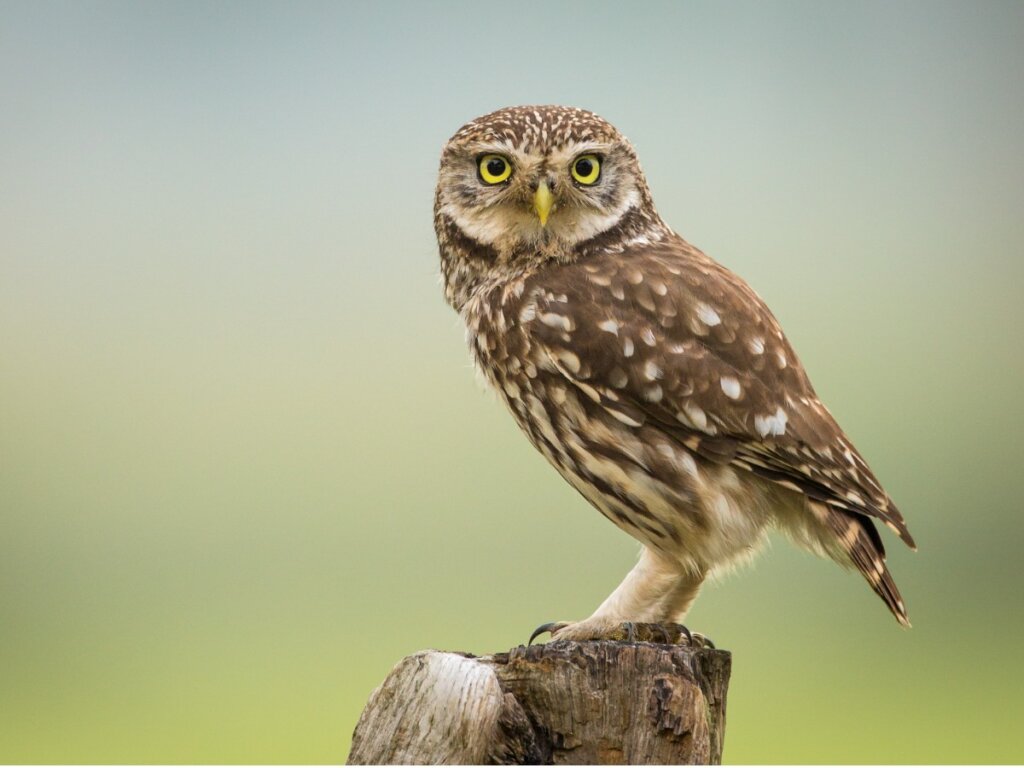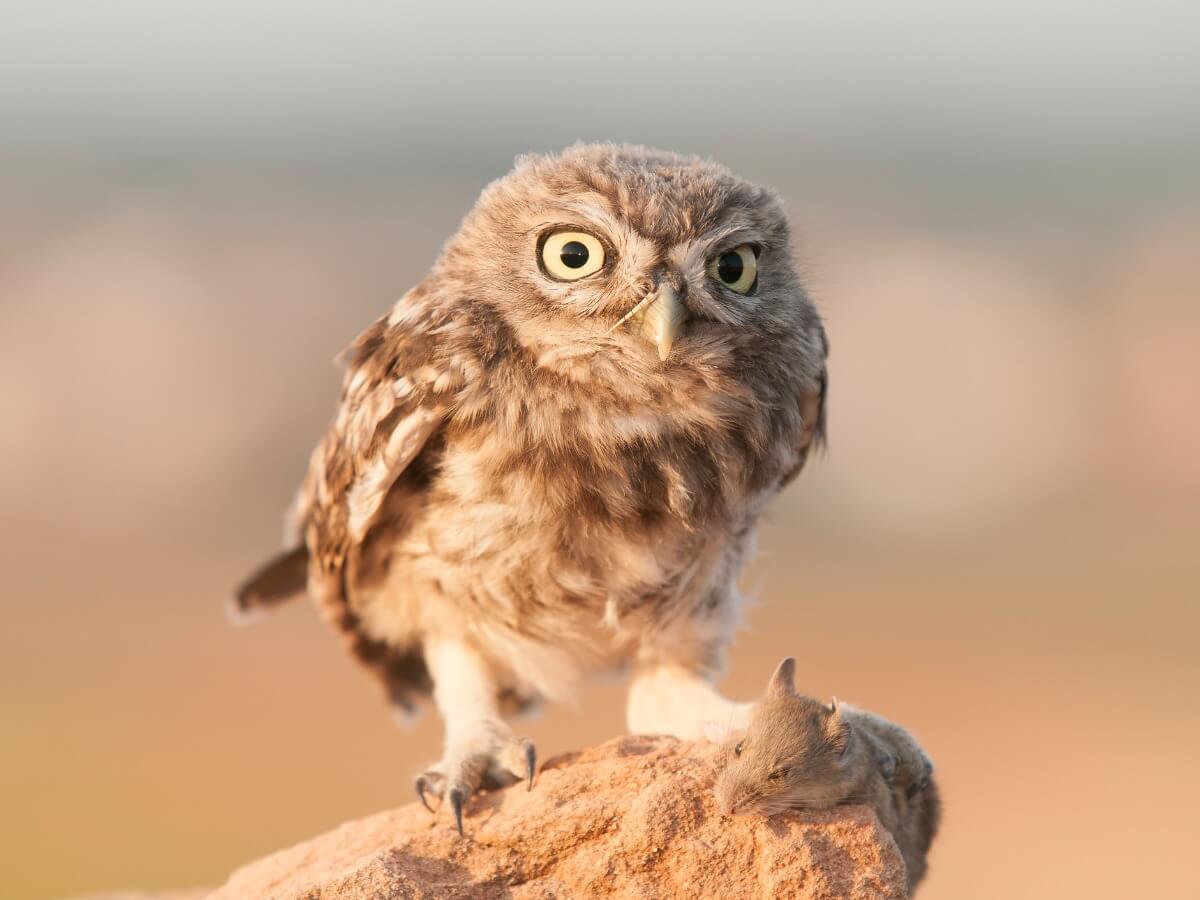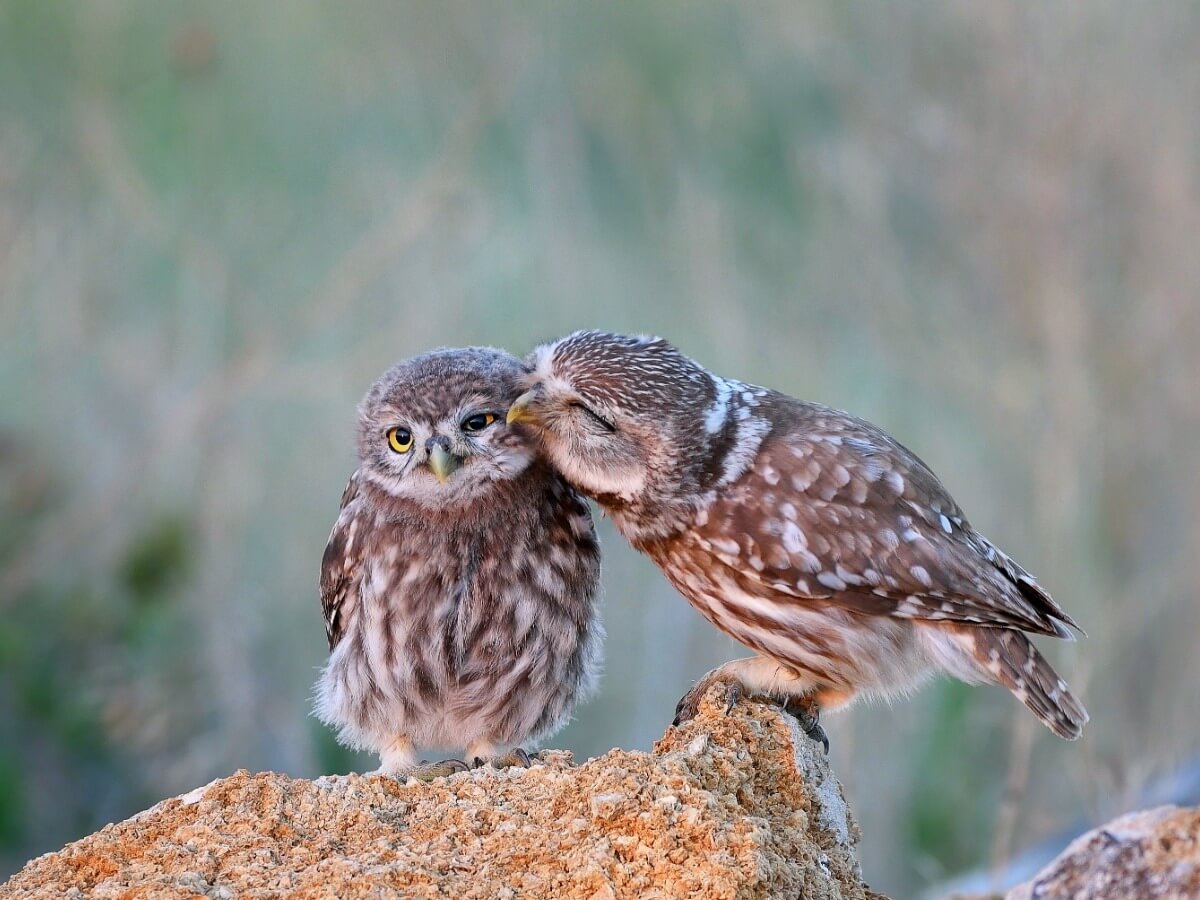The Little Owl: Habitat and Characteristics

Nocturnal birds of prey have always evoked an aura of mystery and fascination and the little owl is no exception. Its eyes, a pair of glowing circles in the middle of the night, are the perfect material for any active imagination, be it for mystical beliefs or horror stories.
In this article, you can get to know this little raptor and its characteristics. Although seeing a little owl up close in nature would be a real stroke of luck, we assure you that on screen they’re also incredible birds.
Physical characteristics
The European little owl (Athene noctua) is a strigiform bird of the Strigidae family. It’s a small raptor, 24 centimeters tall and 50 centimeters wide (around 10 to 20 inches). Weighing about 150 grams (just over 5 ounces), it has a rounded appearance and a broad head. In addition, it exhibits sexual dimorphism, as the female is larger than the male.
Its plumage is mainly grayish-brown. This bird doesn’t have plumes over its eyes and its facial disc isn’t clearly defined. In addition, it has white feathers over its striking yellow eyes and its tarsi are also white-feathered.
The flight of the little owl goes in waves, with continuous descents and ascents and rapid flapping, unlike that of other Strigiformes, which is more linear. This is quite a useful feature to identify it from a distance.

The behavior of the little owl
Unlike other nocturnal birds of prey, their habits are partly crepuscular, so a little owl can be sighted at dusk or dawn — or even during the day. These birds scan the horizon on poles or other perches, as this is where they stalk their prey from.
It’s a monogamous species with stable relationships and it’s normal for the specimens to live in pairs. Between the two members they warn each other of different events through specific vocalizations: courtship, sighting prey, danger or territoriality. Some say their screams sound like meows.
The little owl in mythology
Nocturnal birds of prey are very often associated with wisdom. This comes directly from Greek mythology, as Athena – goddess of wisdom and tactical warfare – had a little owl as a companion. In fact, its scientific name, Athene noctua, pays tribute to this deity.
In the culture of Ancient Rome, however, the owl began as a bad omen, due to its song and its sudden appearances in visible and high places. Later, when adopting the Greek pantheon, this bird took the same place as Minerva’s companion.
It has also had a place in modern philosophy: the thinker Hegel placed the owl as a symbol of philosophy in the nineteenth century. In his words, “the bird of Minerva does not take flight until nightfall”. He wanted to express that philosophy shouldn’t be understood as a predictor or prescriber of events.
Habitat of the little owl
Its geographical distribution covers southern Europe, Central Asia and North Africa. It has a great capacity to adapt to different biotopes, although it shows a preference for sparsely wooded areas, avoiding thick forests and mountain areas.
Have you ever heard of “each owl to its olive tree”? This saying comes from this bird’s preference for olive groves.
In addition, the owl can live in semi-desert areas, fields and orchards. It sometimes nests near human dwellings, finding prey among agricultural plantations without too much trouble.
Little owl feeding
This raptor has a generalist feeding style, that is, it feeds on the sustenance available at each time of the year. Although it’s mainly insectivorous in summer, in winter it feeds mostly on small mammals.
The geographical distribution also influences their diet. The owls that live in regions further north have higher energy expenditure – temperatures are lower – so they hunt more mice and birds than southern populations, who prefer insects.
Reproduction of the little owl
A pair of owls will spend their entire lives in the territory they have chosen as a breeding place. They tend to prefer cavities to build the nest, such as tree holes, buildings, or cracks in rocks. On occasions, they occupy hoopoe or rattle nests.
The breeding season runs from March to April, during which the owls that still don’t have a mate call for each other with slow and melodic songs. The female lays 3 to 5 eggs at intervals of 1 or 2 days. These are incubated for 28-33 days exclusively by the female, while the male feeds her.
The chicks are nesters and remain in the nest for a month until they can become independent. Until then, both the mother and the father take care of their feeding. At the beginning of July, the young begin to fly and in August they’ll already have left the territory of their parents.
The chicks are born blind, bald and completely unprotected. They require very marked parental care in their early life stages.
State of conservation
The little owl has a status of least concern, due in part to its wide distribution throughout Europe. However, it isn’t free of threats from humans: in some regions it’s hunted, and often it dies from ingesting prey poisoned with pesticides or rodenticides. In urban locations, theft is common at night.

Although this little bird isn’t critically endangered, we mustn’t forget that it shares a planet with us. Also, like many other predators, its role in the ecosystem is critical for nature’s balance. You don’t have to like animals, but remember that if rodents don’t eat your crops or mosquitoes don’t bite you, it’s partly thanks to owls. Let’s take care of them as they take care of us!
All cited sources were thoroughly reviewed by our team to ensure their quality, reliability, currency, and validity. The bibliography of this article was considered reliable and of academic or scientific accuracy.
- BirdLife International. 2019. Athene noctua (amended version of 2018 assessment). The IUCN Red List of Threatened Species 2019: e.T22689328A155470112. https://dx.doi.org/10.2305/IUCN.UK.2019-3.RLTS.T22689328A155470112.en. Downloaded on 26 June 2021.
- Ibérica, F. (2017, 10 enero). Mochuelo común o Mochuelo europeo (Athene noctua). Fauna Ibérica. https://www.faunaiberica.org/mochuelo-comun-europeo
- R. (2018, 31 agosto). Mochuelo | Qué es, características, hábitat, reproducción, alimentación. Animales. https://www.animales.website/mochuelo/
- SEO/BirdLife. (2019, 13 febrero). Mochuelo europeo. https://seo.org/ave/mochuelo-europeo/
- Guillén, L. R. N. (2006). Intentando socavar una falsa creencia: la identidad del ave de Atenea. Studium: Revista de humanidades, (12), 103-111.